
Representative money or receipt money is any medium of exchange, printed or digital, that represents something of value, but has little or no value of its own. Unlike some forms of fiat money, genuine representative money must have something of intrinsic value supporting the face value.
Uruk, today known as Warka, was a city in the ancient Near East situated east of the present bed of the Euphrates River on the dried-up ancient channel of the Euphrates. The site lies 93 kilometers northwest of ancient Ur, 108 kilometers southeast of ancient Nippur, and 24 kilometers southeast of ancient Larsa. It is 30 km (19 mi) east of modern Samawah, Al-Muthannā, Iraq.

Cuneiform is a logo-syllabic writing system that was used to write several languages of the Ancient Near East. The script was in active use from the early Bronze Age until the beginning of the Common Era. Cuneiform scripts are marked by and named for the characteristic wedge-shaped impressions which form their signs. Cuneiform is the earliest known writing system and was originally developed to write the Sumerian language of southern Mesopotamia.

The Tărtăria tablets are three tablets, reportedly discovered in 1961 at a Neolithic site in the village of Tărtăria in Săliștea commune, from Transylvania.
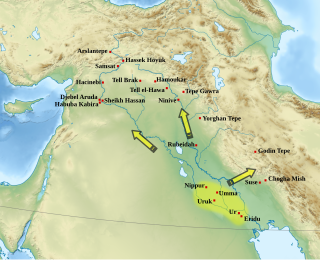
The Uruk period existed from the protohistoric Chalcolithic to Early Bronze Age period in the history of Mesopotamia, after the Ubaid period and before the Jemdet Nasr period. Named after the Sumerian city of Uruk, this period saw the emergence of urban life in Mesopotamia and the Sumerian civilization. The late Uruk period saw the gradual emergence of the cuneiform script and corresponds to the Early Bronze Age; it has also been described as the "Protoliterate period".

The Proto-Elamite period, also known as Susa III, is a chronological era in the ancient history of the area of Elam, dating from c. 3100 BC to 2700 BC. In archaeological terms this corresponds to the late Banesh period. Proto-Elamite sites are recognized as the oldest civilization in the territory of present-day Iran. The Proto-Elamite script is an Early Bronze Age writing system briefly in use before the introduction of Elamite cuneiform.

The Proto-Elamite script is an Early Bronze Age writing system briefly in use before the introduction of Elamite cuneiform.
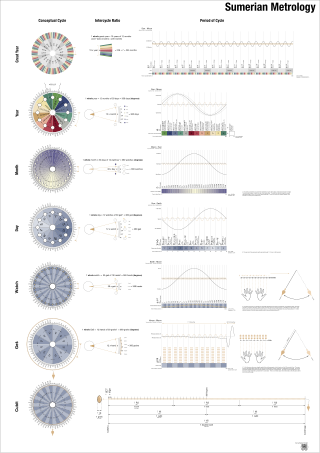
Ancient Mesopotamian units of measurement originated in the loosely organized city-states of Early Dynastic Sumer. Each city, kingdom and trade guild had its own standards until the formation of the Akkadian Empire when Sargon of Akkad issued a common standard. This standard was improved by Naram-Sin, but fell into disuse after the Akkadian Empire dissolved. The standard of Naram-Sin was readopted in the Ur III period by the Nanše Hymn which reduced a plethora of multiple standards to a few agreed upon common groupings. Successors to Sumerian civilization including the Babylonians, Assyrians, and Persians continued to use these groupings. Akkado-Sumerian metrology has been reconstructed by applying statistical methods to compare Sumerian architecture, architectural plans, and issued official standards such as Statue B of Gudea and the bronze cubit of Nippur.
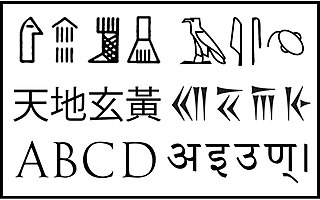
The history of writing traces the development of expressing language by systems and techniques of markings and how these markings were used for various purposes in different societies, thereby transforming social organization. Writing systems are the foundation of literacy and literacy learning, with all the social and psychological consequences associated with literacy activities.

ʿAin Ghazal is a Neolithic archaeological site located in metropolitan Amman, Jordan, about 2 km north-west of Amman Civil Airport. The site is remarkable for being the place where the ʿAin Ghazal statues were found, which are among the oldest large-sized statues ever discovered.
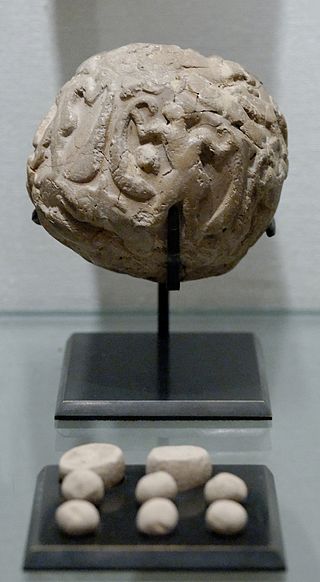
A bulla is an inscribed clay or soft metal or bitumen or wax token used in commercial and legal documentation as a form of authentication and for tamper-proofing whatever is attached to it.
A sign-value notation represents numbers using a sequence of numerals which each represent a distinct quantity, regardless of their position in the sequence. Sign-value notations are typically additive, subtractive, or multiplicative depending on their conventions for grouping signs together to collectively represent numbers.
Number systems have progressed from the use of fingers and tally marks, perhaps more than 40,000 years ago, to the use of sets of glyphs able to represent any conceivable number efficiently. The earliest known unambiguous notations for numbers emerged in Mesopotamia about 5000 or 6000 years ago.
Physicalization of computer hardware, is a way to place multiple physical machines in a rack unit. It can be a way to reduce hardware costs, since in some cases, server processors cost more per core than energy efficient laptop processors, which may make up for added cost of board level integration. While Moore's law makes increasing integration less expensive, some jobs require much I/O bandwidth, which may be less expensive to provide using many less-integrated processors.
Choghā Mīsh (Persian language; چغامیش čoġā mīš) dating back to about 6800 BC, is the site of a Chalcolithic settlement located in the Khuzistan Province Iran on the eastern Susiana Plain. It was occupied at the beginning of 6800 BC and continuously from the Neolithic up to the Proto-Literate period, thus spanning the time periods from Archaic through Proto-Elamite period. After the decline of the site about 4400 BC, the nearby Susa, on the western Susiana Plain, became culturally dominant in this area. Chogha Mish is located just to the east of Dez River, and about 25 kilometers to the east from the ancient Susa. The similar, though much smaller site of Chogha Bonut lies six kilometers to the west.

The Investiture of Zimri-Lim is a large colorful mural discovered at the Royal Palace of the ancient city-state of Mari in eastern Syria. The fresco, which dates back to the 18th century BC, depicts Zimri-Lim, king of Mari, receiving the rod-and-ring symbol from the goddess Ishtar. The painting was discovered in situ on its original wall located opposite the grand doorway to the podium which leads to the throne room of the palace. It was discovered by French archaeologist André Parrot during excavations at Mari in 1935–1936. The painting is now displayed at the Musée du Louvre in Paris, France.
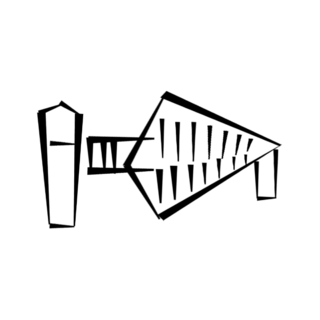
Kushim is supposedly the earliest known recorded name of a person in writing. The name "Kushim" is found on several Uruk period clay tablets used to record transactions of barley. It is uncertain if the name refers to an individual, a generic title of an officeholder, or an institution.
Robert K. Englund was an American Archaeologist and Assyriologist.
Karenleigh A. Overmann is a cognitive archaeologist known for her work on how ancient societies became numerate and literate. She currently directs the Center for Cognitive Archaeology at the University of Colorado, Colorado Springs. Before becoming an academic researcher, Overmann served 25 years of active duty in the U.S. Navy.
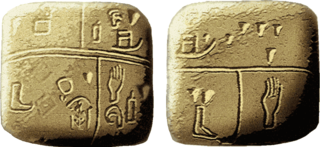
The proto-cuneiform script was a system of proto-writing that emerged in Mesopotamia, eventually developing into the early cuneiform script used in the region's Early Dynastic I period. It arose from the token-based system that had already been in use across the region in preceding millennia. While it is known definitively that later cuneiform was used to write the Sumerian language, it is still uncertain what the underlying language of proto-cuneiform texts were.












